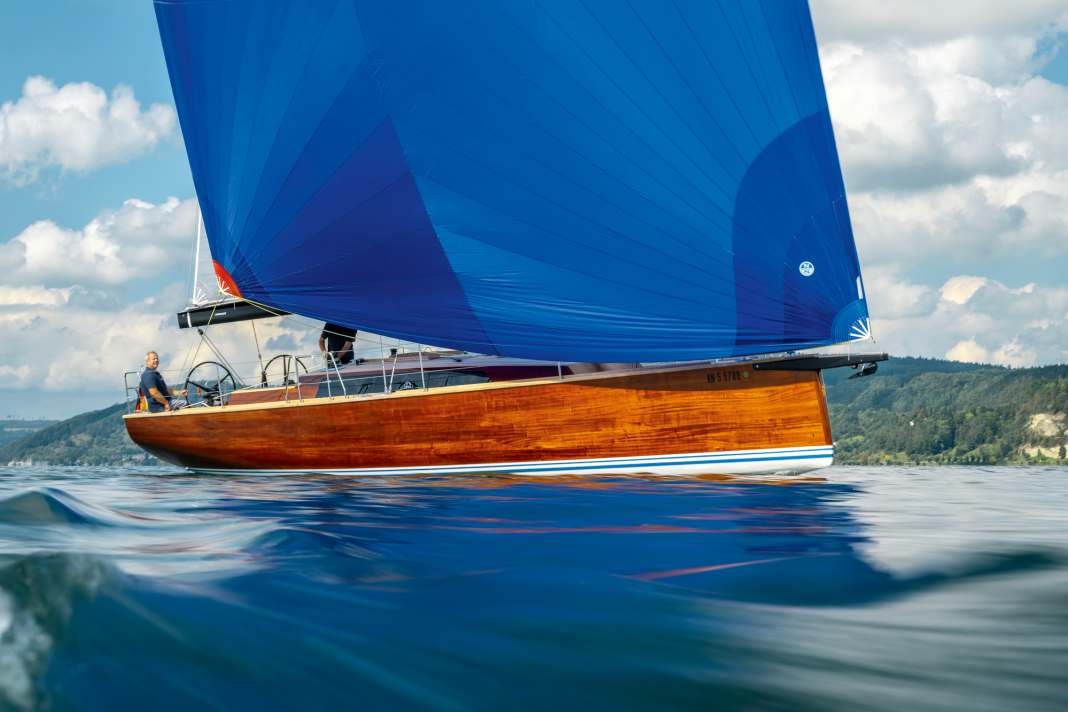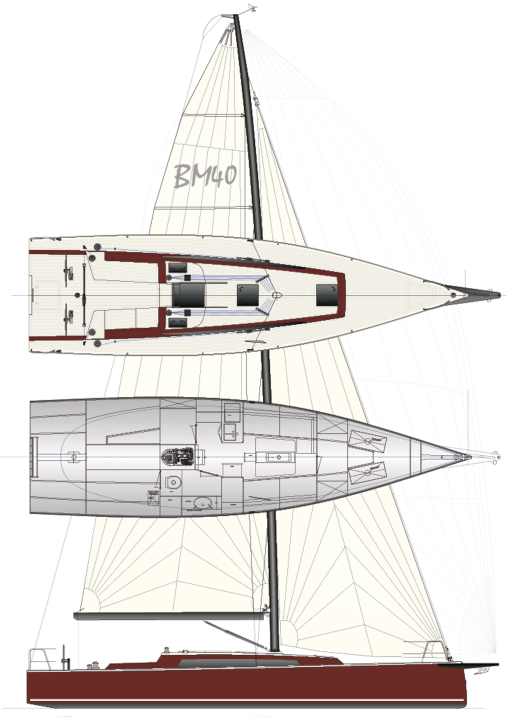





If you had to choose hotspots for particularly pretty, exclusive and exciting sailing boats, Lake Constance would probably be at the top of the list of possible candidates. There are plenty of nautical beauties to be seen there, yachts of exquisite aesthetics with a wow effect. It's not just the often beautifully restored vintage yachts that cruise majestically here and attract attention, but also the many attractive new builds, from elegant retro classics to breathtaking inland racers made of carbon fibre. Lake Constance has become a meeting place for boats of an unusual kind, far removed from the mainstream.
Since this spring, the range of sailing specialities on the Swabian Sea has been enriched by another magnificent custom-built boat. With its excitingly beautiful lines, apparent sportiness and exclusive wooden construction, the "Klippeneck" is currently causing a stir on Lake Constance. It is a yacht with the designation BM 40, which stands for Berckemeyer Yacht Design from Stein on the Kiel Fjord.
"Klippeneck" is a modern, real Bodensee boat
The owner of the "Klippeneck" does not wish to be named in this portrait. It's not about him, but about his new ship, he says. This must be respected. He only says this much for the record: he has owned eleven sailing yachts in his life - so far. Now, with the twelfth and supposedly last ship, it should also be something very special, a purely individual construction, according to his very own wishes and needs - a boat that no one else has and, on top of that, is built entirely from wood. A final, personalised yacht for the rest of his life. Incidentally, the name "Klippeneck" refers to the mountain of the same name on the edge of the Swabian Alb near the owner's home. All of his previous boats have borne this name.
It should be a "real Bodensee boat", not too classic, rather modern, elegant, simple and timeless. And easy to sail, even with a small crew or single-handed. These were the design instructions given to Berckemeyer Yacht Design. Since the death of Oswald Berckemeyer in 2004, Martin Menzner has been the owner of the design office on the Baltic Sea. The graduate product designer and successful regatta sailor has been running the studio on his own ever since and has already designed and co-developed more than a hundred yachts of all types and sizes under the name Berckemeyer (BM) - quite an impressive track record.
Based on the owner's specifications, Martin Menzner designed a strikingly slim, modern and flat hull, suitable for Lake Constance with its predominantly light winds and little swell. Naturally, considerations regarding harbour use also played a role in the design. Berths of over 3.50 metres are rather rare on Germany's second largest inland lake. Owners of slender ships such as the "Klippeneck" therefore still have a chance of finding a berth in their favourite harbour when touring Lake Constance, even during the holiday season and after 3 pm.
Performance cruiser "Klippeneck" starts up in the slightest breeze
The open cockpit is also designed according to modern principles and clearly organised according to function. Halyards and trim lines lead over the coachroof and are operated from the side of the companionway with two large winches. For the genoa and mainsail sheets, there are two more powerful winches aft on deck, which can also be easily operated by the helmsman from his position at the wheel. To do this, he moves a little forwards and takes the wheel between his legs so that he can handle both sheets.
If it had been up to designer Martin Menzner alone, he would have preferred to have the BM 40 built with tiller steering. The design of the hull appendages with the long and slim single rudder would probably have been predestined for this. However, the owner decided in favour of double wheel steering, which in this case does not reduce either the sailing characteristics or the steering feel. The twelve metre long performance cruiser can be steered easily and with a wonderful amount of feeling in the wind. And all it takes is a breeze from Lake Constance for the "Klippeneck" to fire away as if it were setting new course records. There's no doubt about it: the Menzner design has what it takes to sail.
Carbon fibre meets precious wood
After all, sportiness and performance were also on the owner's wish list. Regatta suitability with the potential to win is a priority in his interpretation of the perfect Lake Constance boat. Martin Menzner has therefore given his design a modern, high and slim sail plan and fitted it with a carbon fibre rig from Pauger Carbon Composites with two spreaders and rod shrouds. And it goes without saying that only high-quality laminate material was considered for the Amwind wardrobe. A gennaker and a Code Zero complete the sail inventory of North Sails on the "Klippeneck". A carbon fibre sprit is permanently attached to the bow. The trunk also serves as an anchor holder and is - along with the rig, fittings and steering wheels - one of the few plastic parts on the boat.
Everything else is made from the finest precious wood, assembled at Wilhelm Wagner's shipyard in Bodman, a small, dreamy village at the far end of Lake Überlingen. The family business has been building all kinds of boats here since 1882, and exclusively from wood. Initially it was mainly workboats for professional fishermen, but later robust rowing boats were added to the shipyard's programme, which Wagner still builds in series with great success today. Later, with the completion of the sports boat harbour in Bodman in the 1950s, the shipyard also received its first orders for sailing yachts.
"Klippeneck" manufactured in an elaborate and robust design
Wilhelm (Willi) Wagner has been running the traditional shipyard on Lake Constance since 1982, now in its third generation. He learnt his trade in the shipyard of Josef Martin in neighbouring Radolfzell - his main competitor today when it comes to the production of individual wooden structures, such as the current "Klippeneck". In addition, Wagner also lends itself to extensive restorations and new builds in small series, including the Wagner 23 Classic and Sport models as well as the Wagner 32 and 33 models, which were also created in collaboration with Martin Menzner. The co-operation between the two had already proven itself on a broad basis before the BM 40 project.
Willi Wagner builds the hulls of his boats using a mould-glued construction method over a framework of plywood mouldings. In the case of the "Klippeneck", this means two layers of Cedro wood (similar to mahogany, but more robust and lighter at the same time) diagonally, with a layer of fine-grained mahogany lengthwise on top as the ultimately visible outer skin. The veneers are stapled on in layers and glued together with epoxy resin under vacuum.
To stiffen the hull, longitudinal mahogany stringers are laminated into the moulded hull along the entire length of the hull, three solid strands on each side. You might think that the elaborate and robust construction could also lead to a certain excess weight. But this is not the case - quite the opposite. With a displacement of just six tonnes and a keel weight of 35 percent, the "Klippeneck" is significantly lighter than many comparable performance cruisers in the twelve-metre hull length class, which usually weigh over eight tonnes. Of course, the slimline crack weighs less because less material has to be used for the hull and deck overall. But Wagner also saves pounds on the interior fittings.
Unusual and contrasting design below deck
The floor boards, as well as the doors to storage compartments and cupboards and other covers, are made using the labour-intensive and therefore cost-intensive sandwich construction method with a foam core. The parts are therefore not only more robust and torsion-resistant than their solid wood counterparts, but also significantly lighter.
Modern design language. The stern, with its oval frame and constricted waterline, reflects the current zeitgeist Anyone who goes below deck on the "Klippeneck" is immersed in an initially strange world. Inside, sober, modern functionality overlaps with an almost pompous yacht-building tradition. Here, matt white lacquered surfaces contrast sharply with dark, high-gloss lacquered mahogany. It takes a while for the eye to get used to this unusual and contrasting sight.
However, once you have spent some time in the saloon, the interior also has a lot of charm and cosiness. The light, airy and straightforward style has something of an ultra-modern summer residence on the Mediterranean, but also of a cosy holiday home in Denmark. The owner likes that, and of course that's what he gets.
The layout in the saloon is symmetrical with two sofa berths to port and starboard and a large table with two folding tops between them. The layout in the foredeck is mirrored with two berths and a deep cut-out between the berths. Another double cabin with two separate berths is located aft on the port side.
"Klippeneck" is an eye-catcher on Lake Constance
Then there's the bathroom: huge, with plenty of space for all the things you need to do in a toilet, including showering. There is no partition for this. But there is an opening to crawl through into the generously sized cockpit locker, which can also be reached from the cockpit. Without exception, the entire on-board technology is integrated in there, the electrical wiring with all fuses as well as the pipes for the water circuit with supply to the galley and bathroom. Everything is installed very clearly and is also easily accessible.
The yacht builders in Bodman have put around 7,000 hours of painstaking manual labour into the production of the "Klippeneck". "In addition, there are a number of hidden hours that are simply part of a one-off build," says shipyard boss Willi Wagner.
It should have been worth it: Because wherever the new beauty turns up on Lake Constance, people will turn round to look at it. The boat builder and designer have done a great job and delivered a flawless product to the owner. The construction and finishing qualities are impeccable, craftsmanship of the highest calibre. The boat is tailored to the owner like a tailor-made suit - so that it really fits in the end.
Technical data of the "Klippeneck"
- Designer:Berckemeyer Yacht Design/M. Menzner
- Torso length:12,20 m
- Waterline length:11,25 m
- Width:3,40 m
- Depth:2,20 m
- Weight:6,0 t
- Sail area on the wind:96,0 m²
- machine (Yanmar): 21 kW/29 hp


